B0041VYHGW EBOK (132 page)
Authors: David Bordwell,Kristin Thompson

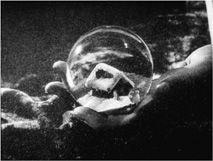
8.29
Citizen Kane:
snow inside and outside the glass ball.
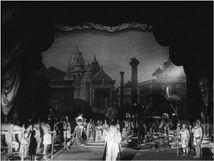
8.30 In
Citizen Kane
’s first opera scene, the camera cranes up from the stage …
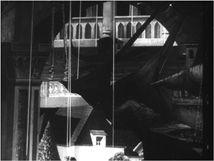
8.31 … through the rigging above …
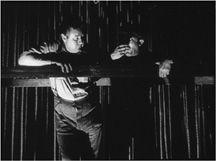
8.32 … to reveal a stagehand indicating that Susan’s singing stinks.
In looking at the development of the narrative form of
Citizen Kane,
we saw how Kane changes from an idealistic young man to a friendless recluse. The film sets up a contrast between Kane’s early life as a newspaper publisher and his later withdrawal from public life after Susan’s opera career fails. This contrast is most readily apparent in the mise-en-scene, particularly the settings of the
Inquirer
office and Xanadu. The
Inquirer
office is initially an efficient but cluttered place. When Kane takes over, he creates a casual atmosphere by moving in his furniture and living in his office. The low camera angles tend to emphasize the office’s thin pillars and low ceilings, which are white and evenly, brightly lit. Eventually, Kane’s collection of crated antiquities clutters his little office. Xanadu, on the other hand, is huge and sparsely furnished. The ceilings are too high to be seen in most shots, and the few furnishings stand far apart. The lighting often strikes figures strongly from the back or side, creating a few patches of hard light in the midst of general darkness. The expanded collection of antiquities and mementoes now is housed in cavernous storerooms.
The contrast between the
Inquirer
office and Xanadu is also created by the sound techniques associated with each locale. Several scenes at the newspaper office (Kane’s initial arrival and his return from Europe) involve a dense sound mix with a babble of overlapping voices. Yet the cramped space is suggested by the relative lack of resonance in timbre. In Xanadu, however, the conversations sound very different. Kane and Susan speak their lines to each other slowly, with pauses between. Moreover, their voices have an echo effect that combines with the setting and lighting to convey a sense of huge, empty space.
The transition from Kane’s life at the
Inquirer
to his eventual seclusion at Xanadu is suggested by a change in the mise-en-scene at the
Inquirer.
As we have just seen, while Kane is in Europe, the statues he sends back begin to fill up his little office. This hints at Kane’s growing ambitions and declining interest in working personally on his newspaper. This change culminates in the last scene in the
Inquirer
office—Leland’s confrontation with Kane. The office is being used as a campaign headquarters. With the desks pushed aside and the employees gone, the room looks larger and emptier than it had in earlier scenes. Welles emphasizes this by placing the camera at floor level and shooting from a low angle (
5.107
). The Chicago
Inquirer
office, with its vast, shadowy spaces, also picks up this pattern
(
8.33
),
as do later conversation scenes in the huge rooms of Xanadu (
8.28
).
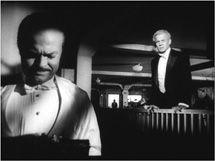
8.33 In
Citizen Kane,
deep-focus photography and rear projection exaggerate the depth of the
Inquirer
office, making the characters seem far apart.
Contrast these scenes with one near the end of the film. The reporters invade Kane’s museumlike storeroom at Xanadu
(
8.34
).
Although the echoing inside Xanadu conveys its cavernous quality, the reporters transform the setting briefly by the same sort of dense, overlapping dialogue that characterized the early
Inquirer
scenes and the scene after the newsreel. By bringing together these reporters and Kane’s final surroundings, the film creates another contrasting parallel emphasizing the changes in the protagonist.
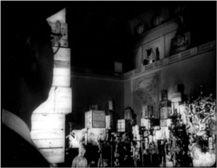
8.34
Citizen Kane:
deep focus in the final scene.
Parallelism is an important feature throughout
Citizen Kane,
and most of the salient techniques work to create parallels in the ways we’ve already seen. For example, the use of deep focus and deep space to pack many characters into the frame can create significant similarities and contrasts. Late in Thatcher’s account (
segment 4
), a scene presents Kane’s financial losses in the Depression. He is forced to sign over his newspaper to Thatcher’s bank. The scene opens with a close-up of Kane’s manager, Bernstein, reading the contract
(
8.35
).
He lowers the paper to reveal Thatcher, now much older, seated opposite him. We hear Kane’s voice offscreen, and Bernstein moves his head slightly, the camera reframing a little. Now we see Kane pacing beyond them in a huge office or boardroom
(
8.36
).
The scene is a single take in which the dramatic situation is created by the arrangement of the figures and the image’s depth of field. The lowering of the contract recalls the previous scene, in which we first get a real look at the adult Kane as Thatcher puts down the newspaper that has concealed him
(
8.37
,
8.38
).
There Thatcher had been annoyed, but Kane could defy him. Years later in the story, Thatcher has gained control and Kane paces restlessly, still defiant, but stripped of his power over the
Inquirer
chain. The use of a similar device to open these two scenes sets up a contrasting parallel between them.
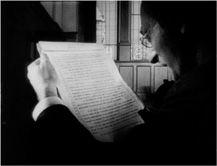
8.35 The contract scene in
Citizen Kane
…
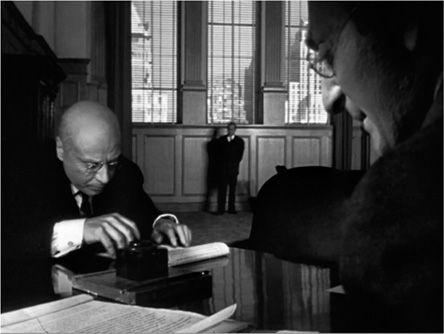
8.36 … with Kane in the background of the shot …
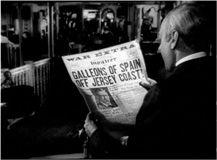
8.37 … echoes this earlier scene’s composition …
